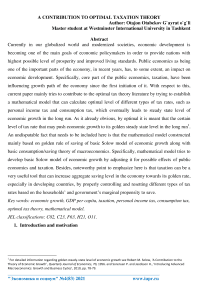A contribution to optimal taxation theory
Автор: Otabekov O.G.
Журнал: Экономика и социум @ekonomika-socium
Рубрика: Основной раздел
Статья в выпуске: 4-1 (83), 2021 года.
Бесплатный доступ
Currently in our globalized world and modernized societies, economic development is becoming one of the main goals of economic policymakers in order to provide nations with highest possible level of prosperity and improved living standards. Public economics as being one of the important parts of the economy, in recent years, has, to some extent, an impact on economic development. Specifically, core part of the public economics, taxation, have been influencing growth path of the economy since the first initiation of it. With respect to this, current paper mainly tries to contribute to the optimal tax theory literature by trying to establish a mathematical model that can calculate optimal level of different types of tax rates, such as personal income tax and consumption tax, which eventually leads to steady state level of economic growth in the long run. As it already obvious, by optimal it is meant that the certain level of tax rate that may push economic growth to its golden steady state level in the long run[22]. An undisputable fact that needs to be included here is that the mathematical model constructed mainly based on golden rule of saving of basic Solow model of economic growth along with basic consumption/saving theory of macroeconomics. Specifically, mathematical model tries to develop basic Solow model of economic growth by adjusting it for possible effects of public economics and taxation. Besides, noteworthy point to emphasize here is that taxation can be a very useful tool that can increase aggregate saving level in the economy towards its golden rate, especially in developing countries, by properly controlling and resetting different types of tax rates based on the households’ and government’s marginal propensity to save.
Economic growth, gdp per capita, taxation, personal income tax, consumption tax, optimal tax theory, mathematical model
Короткий адрес: https://sciup.org/140260434
IDR: 140260434
Список литературы A contribution to optimal taxation theory
- Atkinson, A. and Stiglitz, J., (1976). The design of tax structure: Direct versus indirect taxation. Journal of Public Economics, 6(1-2), pp.55-75.
- Cournot, A. (1838) Recherches sur les Principes Mathématiques de la Théorie des Richesses, Paris: Librairie des Sciences Politiques et Sociales.
- Diamond, P. and Mirrlees, J., (2002). Optimal Taxation and The Le Chatelier Principle. SSRN Electronic Journal,.
- Edgeworth, F.Y. (1925) “The pure theory of monopoly“ in Papers Relating to Political Economy, New York: Burt Franklin.
- Griffith, R., Redding, S. and Van Reenen, J., (2003). R&D and absorptive capacity: theory and empirical evidence. Scandinavian journal of Economics, 105(1), pp.99-118. Mankiw, N., Weinzierl, M. and Yagan, D., 2009. Optimal Taxation in Theory and Practice. SSRN Electronic Journal,.
- Mirrlees, J., (1971). An Exploration in the Theory of Optimum Income Taxation. The Review of Economic Studies, 38(2), p.175.
- Mirrlees, J., (1976). Optimal tax theory. Journal of Public Economics, 6(4), pp.327-358.
- Nerlove, M. and Arrow, K.J., (1962). Optimal advertising policy under dynamic conditions. Economica, pp.129-142.
- Ramsey, F.P. (1927) “A Contribution to the theory of taxation”, Economic Journal, 37, 47-61.
- Ricardo, D. (1817) The Principles of Political Economy and Taxation, London: M. Dent and Sons.
- Robert M. Solow (1956). ‘A Contribution to the Theory of Economic Growth’, Quarterly Journal of Economics, 70.
- ROMER, P. (1986). Increasing Returns and Long-Run Growth. The Journal of Political Economy. 94 (5), pp. 1002-1037.
- Romer, P. (1990), “Endogenous Technological Change”, Journal of Political Economy, Vol. 96, pp. S71-S102.
- Romer, P.M., 1987. Growth based on increasing returns due to specialization. The American Economic Review, 77(2), pp.56-62.
- Schumpeter, J. and Nichol, A., (1934). Robinson's economics of imperfect competition. Journal of political economy, 42(2), pp.249-259.
- Smith, Adam. An inquiry into the nature and causes of the Wealth of Nations. Edited by S. M. Soares. MeTaLibri Digital Library, 29th May 2007.
- Solow, R. (1956). A Contribution to the Theory of Economic Growth. The Quartely Journal of Economics. 70 (1), pp. 65-94.
- Sorensen P. and Jacobson H., ‘Introducing Advanced Macroeconomics: Growth and Business Cycles’, 2010, pp. 78-79.


